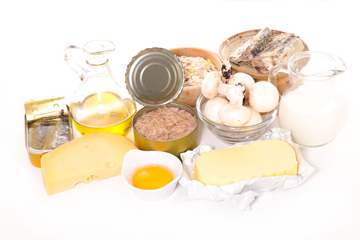 One of the many nutrients we need, Vitamin D helps the body absorb calcium, which builds and keeps the bones strong and healthy. As it is produced by the body in response to skin being exposed to sunlight, vitamin D is also known as the sunshine vitamin. Regardless of its name, Vitamin D is not actually a vitamin and is considered a pro-hormone.
One of the many nutrients we need, Vitamin D helps the body absorb calcium, which builds and keeps the bones strong and healthy. As it is produced by the body in response to skin being exposed to sunlight, vitamin D is also known as the sunshine vitamin. Regardless of its name, Vitamin D is not actually a vitamin and is considered a pro-hormone.
Vitamin D plays a role in muscle function and the immune system (the body’s defense system). It helps protect against infections and other illnesses. It also aids diabetes management by regulating insulin levels and also supports lung function and cardiovascular health. Taking vitamin D every day has been shown to reduce the risk of falling in older individuals. On the other hand, vitamin D deficiencies have been linked to cardiovascular disease and mortality, high blood pressure, stroke and diabetes. In children, deficiency of the sunshine vitamin causes rickets.
According to an article in Medical News Today, recent studies suggest that a substantial percentage of the global population is vitamin D deficient. Sunlight is the best natural source of vitamin D. You can also increase your Vit D levels through dietary changes. The Reference Daily Intake (RDI) for people age 1-70 is 600 IU and age 71 and older is 800IU of vitamin D per day from foods. Here are 10 top vitamin D rich foods:
- Oily fish: Popular fatty fishes such as salmon, sardines, swordfish are a great source of vitamin D. Sockeye salmon is also a great source of vitamin B12, niacin, and thiamin. In addition to being rich in omega-3 fatty acids, sockeye salmon is packed with numerous minerals, including selenium and phosphorus.
- Shrimp: This popular type of shellfish contain a good amount of vitamin D – 152 IU per serving, or 25% of the RDI. However, it also contains useful omega-3 fatty acids, although at lower amounts than many other vitamin D rich foods.
- Egg Yolks: This protein-rich food, especially the yolk, is also a great source of Vit D. Pasture-raised or free-range chickens that roam outside in the sunlight produce eggs with Vit D levels 3-4 times higher.
- Cod Liver Oil: An excellent source of Vitamin D, cod liver oil is a popular supplement. A non-fish eater can take this supplement to obtain certain nutrients unavailable in other sources. Cod liver oil contains 450 international units (IU) per teaspoon, which is 75 percent of a person’s recommended daily allowance (RDA).
- Fortified Milk: Fortified cow’s milk is a good source of vitamin D and many nutrients including calcium, vitamin B12, phosphorous and riboflavin. One cup of milk can cover around 30% of your daily value of vitamin D.
- Cheese: This is another source of vitamin D for vegetarians. Cheese is also a great source of vitamin A, riboflavin, and numerous minerals, including calcium, phosphorus, zinc, and selenium.
- Yogurt: Highly nutritious and enriched with Vitamin D, yogurt is a super food. This dairy product provides different amounts of this important nutrient, depending on the brand. It also contains vitamin B, calcium, phosphorus, and other minerals.
- Fortified Foods: Some manufacturers add vitamin D or other nutrients to many commercially available foods and label them ‘fortified’. Common foods enriched vitamin D and other nutrients include cow’s milk, orange juice, various breakfast cereals, and soy milk.
- Oysters: In addition to being delicious, low in calories and full of nutrients, oyster also provides 53% of the Recommended Dietary Intake (RDI) for vitamin D.
- Mushroom: These are the only plant source of vitamin D. Like humans, mushrooms can synthesize this vitamin when exposed to UV light. Only wild mushrooms or mushrooms treated with UV light are good sources of vitamin D.
Eating plenty of these foods can increase your vitamin D levels. However, along with dietary changes, make sure to spend some time out in the sun, as it is the best source of vitamin D.